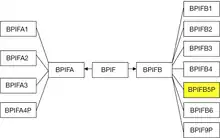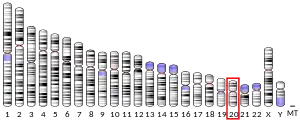| BPIFB5P | |||||||||||||||||||||||||||||||||||||||||||||||||||
|---|---|---|---|---|---|---|---|---|---|---|---|---|---|---|---|---|---|---|---|---|---|---|---|---|---|---|---|---|---|---|---|---|---|---|---|---|---|---|---|---|---|---|---|---|---|---|---|---|---|---|---|
| Identifiers | |||||||||||||||||||||||||||||||||||||||||||||||||||
| Aliases | BPIFB5P, BPI fold containing family B member 5, pseudogene | ||||||||||||||||||||||||||||||||||||||||||||||||||
| External IDs | GeneCards: BPIFB5P | ||||||||||||||||||||||||||||||||||||||||||||||||||
| |||||||||||||||||||||||||||||||||||||||||||||||||||
| |||||||||||||||||||||||||||||||||||||||||||||||||||
| Wikidata | |||||||||||||||||||||||||||||||||||||||||||||||||||
| |||||||||||||||||||||||||||||||||||||||||||||||||||
BPI fold containing family B, member 5 is a non-human protein encoded by the Bpifb5 gene, also known as Lplunc5. The BPIFB5 protein and Bpifb5 gene have been characterized in mammals such as rodents (mouse,[3] rat[4]) and even-toed ungulates (pig,[5] cow[6]) but are apparently lacking in primates and other vertebrates such as birds, reptiles, and amphibians.[7] The protein in rodents is expressed at moderately high levels in mucosa of the airways (respiratory and olfactory epithelium) and at moderate levels in salivary glands, esophagus, and gonads (ovary, testis);[8] in even-toed ungulates expression is high in testis, moderate in brain and striated muscle, and low in kidney.[9][10]
In humans no protein is expressed and it is present only as a pseudogene BPIFB5P.[11] The pseudogene was named based on its functional ortholog found in the other species.[12]
Superfamily
BPIFB5 is a member of the BPI fold protein superfamily defined by the presence of the bactericidal/permeability-increasing protein fold (BPI fold) which is formed by two similar domains in a "boomerang" shape.[13] This superfamily is also known as the BPI/LBP/PLUNC family or the BPI/LPB/CETP family.[14] The BPI fold creates apolar binding pockets that can interact with hydrophobic and amphipathic molecules, such as the acyl carbon chains of lipopolysaccharide found on Gram-negative bacteria, but members of this family may have many other functions.

Genes for the BPI/LBP/PLUNC superfamily are found in all vertebrate species, including distant homologs in non-vertebrate species such as insects, mollusks, and roundworms.[15][16] Within that broad grouping is the BPIF gene family whose members encode the BPI fold structural motif and are found clustered on a single chromosome, e.g., Chromosome 20 in humans, Chromosome 2 in mouse, Chromosome 3 in rat, Chromosome 17 in pig, Chromosome 13 in cow. The BPIF gene family is split into two groupings, BPIFA and BPIFB. In humans, BIPFA consists of 3 protein encoding genes BPIFA1, BPIFA2, BPIFA3, and 1 pseudogene BPIFA4P; while BPIFB consists of 5 protein encoding genes BPIFB1, BPIFB2, BPIFB3, BPIFB4, BPIFB6 and 2 pseudogenes BPIFB5P, BPIFB9P. What appears as pseudogenes in humans may appear as fully functional genes in other species.
The human BPIFB5P pseudogene is found clustered with other members of the BPIF gene family conforming to the pattern observed in mammals, but this is not the case for other vertebrate species. In a systematic analysis of the chicken genome, the Lplunc1(Bpifb1) / Lplunc5(Bpifb5) branch of the gene family was determined to be absent, therefore BPIFB1 and BPIFB5 proteins likely arose only after the speciation of mammals.[17]
References
- 1 2 3 GRCh38: Ensembl release 89: ENSG00000233146 - Ensembl, May 2017
- ↑ "Human PubMed Reference:". National Center for Biotechnology Information, U.S. National Library of Medicine.
- ↑ "Mus musculus BPI fold containing family B, member 5 (Bpifb5), mRNA". 17 June 2021.
- ↑ "Bpifb5 BPI fold containing family B, member 5 [Rattus norvegicus (Norway rat)] - Gene - NCBI".
- ↑ "Sus scrofa long palate lung and nasal epithelium protein 5 (BPIFB5), mRNA". 1 July 2020.
- ↑ "Bos taurus BPI fold containing family B, member 5 (BPIFB5), mRNA". 4 July 2020.
- ↑ "bpifb5 - Gene - NCBI". www.ncbi.nlm.nih.gov.
See: "Results by taxon"
- ↑ "Gene : Bpifb5 - ENSMUSG00000038572". bgee.org. The Bgee suite: integrated curated expression atlas and comparative transcriptomics in animals. Retrieved 15 February 2023.
- ↑ "Gene : BPIFB5 - ENSBTAG00000031361". bgee.org. The Bgee suite: integrated curated expression atlas and comparative transcriptomics in animals. Retrieved 15 February 2023.
- ↑ "Gene : BPIFB5 - ENSSSCG00000007262". bgee.org. The Bgee suite: integrated curated expression atlas and comparative transcriptomics in animals. Retrieved 15 February 2023.
- ↑ "BPIFB5P BPI fold containing family B member 5, pseudogene [Homo sapiens (human)] - Gene - NCBI".
- ↑ "Symbol report for BPIFB5P". www.genenames.org. HUGO Gene Nomenclature Committee.
- ↑ Beamer LJ, Carroll SF, Eisenberg D (April 1998). "The BPI/LBP family of proteins: a structural analysis of conserved regions". Protein Science. 7 (4): 906–914. doi:10.1002/pro.5560070408. PMC 2143972. PMID 9568897.
- ↑ "CDD Conserved Protein Domain Family: BPI". www.ncbi.nlm.nih.gov.
- ↑ Beamer LJ, Fischer D, Eisenberg D (July 1998). "Detecting distant relatives of mammalian LPS-binding and lipid transport proteins". Protein Science. 7 (7): 1643–1646. doi:10.1002/pro.5560070721. PMC 2144061. PMID 9684900.
- ↑ Bingle CD, Seal RL, Craven CJ (August 2011). "Systematic nomenclature for the PLUNC/PSP/BSP30/SMGB proteins as a subfamily of the BPI fold-containing superfamily". Biochemical Society Transactions. 39 (4): 977–983. doi:10.1042/BST0390977. PMC 3196848. PMID 21787333.
- ↑ Chiang SC, Veldhuizen EJ, Barnes FA, Craven CJ, Haagsman HP, Bingle CD (March 2011). "Identification and characterisation of the BPI/LBP/PLUNC-like gene repertoire in chickens reveals the absence of a LBP gene". Developmental and Comparative Immunology. 35 (3): 285–295. doi:10.1016/j.dci.2010.09.013. PMC 3253384. PMID 20959152.
External links
- Human BPIFB5P genome location and BPIFB5P gene details page in the UCSC Genome Browser.

